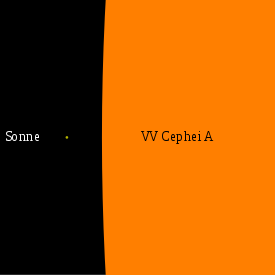VV Cephei
|
Double star VV Cephei |
|||||||||||||||||||||||
|---|---|---|---|---|---|---|---|---|---|---|---|---|---|---|---|---|---|---|---|---|---|---|---|

|
|||||||||||||||||||||||
| Size comparison between the sun and VV Cephei A | |||||||||||||||||||||||
|
Observation dates equinox : J2000.0 , epoch : J2000.0 |
|||||||||||||||||||||||
| AladinLite | |||||||||||||||||||||||
| Constellation | Cepheus | ||||||||||||||||||||||
| Right ascension | 21 h 56 m 39.1 s | ||||||||||||||||||||||
| declination | + 63 ° 37 ′ 32.0 ″ | ||||||||||||||||||||||
| Apparent brightness | 4.91 mag | ||||||||||||||||||||||
| Astrometry | |||||||||||||||||||||||
| parallax | 1.33 ± 0.20 mas | ||||||||||||||||||||||
| distance | 4900 ly (1500 pc ) |
||||||||||||||||||||||
| orbit | |||||||||||||||||||||||
| period | 7430 days | ||||||||||||||||||||||
| Major semi-axis | 0 ", 0120 ± 0", 0011 | ||||||||||||||||||||||
| Individual data | |||||||||||||||||||||||
| Names | A ; B. | ||||||||||||||||||||||
| Observation data: | |||||||||||||||||||||||
| Apparent brightness | A. | 5.18 likes | |||||||||||||||||||||
| B. | 6.66 likes | ||||||||||||||||||||||
| Typing: | |||||||||||||||||||||||
| Spectral class | A. | M2 Iaep | |||||||||||||||||||||
| B. | B6 IIe | ||||||||||||||||||||||
| Physical Properties: | |||||||||||||||||||||||
|
Absolute vis. Brightness M vis |
A. | −8.0 mag | |||||||||||||||||||||
| B. | −6.2 mag | ||||||||||||||||||||||
|
Absolute bol. Brightness M bol |
A. | −9.5 mag | |||||||||||||||||||||
| B. | −7.8 mag | ||||||||||||||||||||||
| Dimensions | A. | 25–40 or 100 M ☉ | |||||||||||||||||||||
| B. | 20 M ☉ | ||||||||||||||||||||||
| radius | A. | 1600–1900 R ☉ | |||||||||||||||||||||
| B. | 10 R ☉ | ||||||||||||||||||||||
| Luminosity | A. | 275000-575000 L ☉ | |||||||||||||||||||||
| B. | 100,000 L ☉ | ||||||||||||||||||||||
| Effective temperature | A. | 3300-3650 K | |||||||||||||||||||||
| B. | 10000-28000 K | ||||||||||||||||||||||
| Other names and catalog entries |
|||||||||||||||||||||||
|
|||||||||||||||||||||||
VV Cephei is a binary star system located in the constellation Cepheus . The double system is about 4900 light years away from our earth. It consists of a red supergiant , VV Cephei A, who crosses the Roche line when it comes closest to its partner - VV Cephei B, a blue giant . Then matter flows from him to his blue partner. The Blue Star seems to belong to the main sequence , but it has probably already torn a lot of mass from VV Cephei A.
Surname
The first part of the name “VV” follows the rules for naming variable stars and states that VV Cephei is the fortieth variable star discovered in the constellation Cepheus. The second part of the name "Cephei" corresponds to the genitive of the Latin name of the constellation Cepheus.
Physical Properties
VV Cephei A
The supergiant VV Cephei A is one of the largest known stars in the Milky Way . It belongs to the M2 spectral class and is approximately 1,600 to 1,900 times the diameter of the sun . If it were at the position of the sun, then its greatest extent would even include the orbit of Saturn . In terms of volume, the sun would fit about 5.3 billion times into VV Cephei A. Its brightness is approximately 275,000 to 575,000 times the luminosity of the sun. The mass of the star is estimated by astronomers on the basis of the movement of bodies in its orbit at a mass of ~ 5 * 10 31 to ~ 2 * 10 32 kg, which would be 25 to 100 times that of the sun. On the other hand, a calculation based on its brightness results in between 25 and 40 solar masses.
VV Cephei B
VV Cephei B is a main series blue giant . It is a B-star with ten times the solar diameter and 100,000 times the solar brightness. One revolution of the system takes 7430 days (20.3 years). Its eclipse lasts about 650 days; his last occultation by VV Cephei A took place from August 4, 2017 to May 16, 2019. The apparent brightness of the system fell from 4.8 to 5.4 mag.
Eclipsing star
The light curve shows almost no change, while VV Cephei B (blue) passes the supergiant VV Cephei A:

The light curve, however, drops suddenly as soon as VV Cephei B passes behind VV Cephei A:

See also
Web links
- SIMBAD entry for VV Cephei
- Hα observations on the binary star system VV Cephei
- http://www.hposoft.com/Astro/PEP/VVCephei.html
- http://www.astro.uiuc.edu/~kaler/sow/vvcep.html
- Space.Com
- Universe Today
- Size comparison of the planets up to the largest stars (video with English names)
Individual evidence
- ↑ a b c SIMBAD Query Result: V * VV Cep - Eclipsing binary of Algol type. Center de Données astronomiques de Strasbourg, accessed on November 10, 2008 (English).
- ↑ Dr. Thomas G. Franke, William B. Albrecht, Terri Osland: The Brightest Stars. Retrieved September 29, 2008 .
- ↑ Heaven's Almanac 2017 . In: Ronald Stoyan (Ed.): Adventure Astronomy . Special issue 2 / 2017. Oculum-Verlag, October 2016, ISSN 2366-3944 , p. 31 .